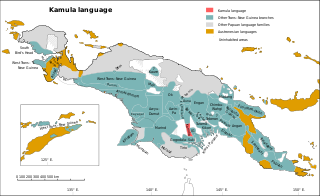| Kamula | |
|---|---|
| Wawoi | |
| Region | Western Province, Papua New Guinea |
| Native speakers | (1,100 cited 2000) |
| Language family | Trans–New Guinea or unclassified
|
| Language codes | |
| ISO 639-3 | xla |
| Glottolog | kamu1260 |
| ELP | Kamula |
 Map: The Kamula language of New Guinea
The Kamula language
Other Trans–New Guinea languages
Other Papuan languages
Austronesian languages
Uninhabited Map: The Kamula language of New Guinea
The Kamula language
Other Trans–New Guinea languages
Other Papuan languages
Austronesian languages
Uninhabited | |
| Coordinates: 6°57′07″S 142°39′17″E / 6.951833°S 142.654804°E / -6.951833; 142.654804 (Kasigi) | |
Download coordinates as:
Kamula (Kamira, Wawoi) is a Trans–New Guinea language that is unclassified within that family in the classification of Malcolm Ross (2005). Noting insufficient evidence, Pawley and Hammarström (2018) leave it as unclassified.
Demographics
Kamula is spoken in two widely separated areas, including in Kamiyami village of the Wawoi Falls area in Bamu Rural LLG, Western Province, Papua New Guinea.
Routamaa (1994: 7) estimates that there are about 800 speakers of Kamula located in 3 villages in Western Province, with no dialectal differences reported. This is because the Kamula had originally lived in camps near Samokopa in the northern area, but a group had split off and moved to Wasapea in the south only around 50 years ago.
- Kesiki, at Wawoi Falls in Bamu Rural LLG (main village) (6°57′07″S 142°39′17″E / 6.951833°S 142.654804°E / -6.951833; 142.654804 (Kasigi))
- Samokopa in Bamu Rural LLG (one day's walk from Kesiki) (6°55′52″S 142°44′48″E / 6.931064°S 142.746689°E / -6.931064; 142.746689 (Samakopa))
- Wasapea (Kamiyami) in Gogodala Rural LLG (seven days' walk, or 90 km to the south of Kesiki) (7°53′20″S 142°38′56″E / 7.889003°S 142.648998°E / -7.889003; 142.648998 (Wasapeya))
In the northern villages of Kesiki and Samokopa, Kamula children were reported as preferring to speak Doso over Kamula. A minority of Kamula people in the northern area also live in Dibiyaso-speaking villages, where they are multilingual in Kamula, Doso, and Dibiyaso. Kamula people in the southern village of Wasapea are also fluent in Gogodala.
Classification
The little data that exists for Kamula pronouns does not fit in with the neighboring East Strickland or Bosavi languages (though 1sg nê likely reflects proto-TNG *na), so Kamula is best left as an unclassified language an independent branch of Trans–New Guinea pending further study.
Attested pronouns are 1sg nɛ̃, 2sg wɛ̃, and ̩pl diɛ.
Phonology
Kamula phonology:
Consonants
Kamula has 12 consonants.
| Bilabial | Dental | Alveolar | Palatal | Velar | Glottal | |
|---|---|---|---|---|---|---|
| plosive | p | t̪ | d | k ɡ | ||
| nasal | m | n | ||||
| fricative | s | h | ||||
| approximant | w | j | ||||
| lateral approximant | l |
Vowels
Kamula has 7 vowels.
| Front | Central | Back | |
|---|---|---|---|
| close | i | u | |
| close-mid | e | o | |
| open-mid | ɛ ⟨a꞉⟩ | ɔ ⟨o꞉⟩ | |
| open | a |
Vocabulary
The following basic vocabulary words are from Dutton (2010), Reesink (1976), and Shaw (1986), as cited in the Trans-New Guinea database:
gloss Kamula head dokupala; tɔkɔnʌlʌ hair kokosasi; kɔkɔsʌse ear molo; mɔlɔ eye inʌma; inoma nose mu; mũ tooth ɛpe tongue te; tɛ leg ɛtɛ; hetei louse iyʌ; iya dog ɛsemala; esemʌlʌ pig ʌľiʌ bird tea egg temoko; temɔkɔ blood umali; umʌ:li bone ɛľu; ɛro skin kapala; kʌpʌlʌ breast mɛmɛ tree dali; tʌli man ɔpɔlʌimi; opřami woman eya; ɛ̃yã sun sali; sʌľi moon mama; mʌmʌ water yu fire deľʌpʌ; dřaƀa stone ewʌľʌ; yawařa road, path api name hi eat dampřoma; tʌɛdɔma one hatropɛ; hʌtɔlɔp two dapiamɛtɛ; depiʌmɛtɛ
References
- Kamula at Ethnologue (25th ed., 2022)

- ^ Pawley, Andrew; Hammarström, Harald (2018). "The Trans New Guinea family". In Palmer, Bill (ed.). The Languages and Linguistics of the New Guinea Area: A Comprehensive Guide. The World of Linguistics. Vol. 4. Berlin: De Gruyter Mouton. pp. 21–196. ISBN 978-3-11-028642-7.
- Eberhard, David M.; Simons, Gary F.; Fennig, Charles D., eds. (2019). "Papua New Guinea languages". Ethnologue: Languages of the World (22nd ed.). Dallas: SIL International.
- Routamaa, Judy. 1994. Kamula grammar essentials.
- Routamaa, Judy. 1997. Orthography paper Kamula, Western province.
- ^ Routamaa, Iska and Judy Routamaa. 1996. Dialect survey report of the Kamula language, Western province.
- United Nations in Papua New Guinea (2018). "Papua New Guinea Village Coordinates Lookup". Humanitarian Data Exchange. 1.31.9.
- Routamaa, Judy. 1995. Kamula phonology essentials.
- Dutton, Tom E. 2010. Reconstructing Proto Koiarian: The history of a Papuan language family. Canberra: Pacific Linguistics.
- Reesink, Ger. 1976. Languages of the Aramia River Area. Papers in New Guinea Linguistics No. 19. Canberra: Pacific Linguistics.
- Shaw, R.D. "The Bosavi language family". In Laycock, D., Seiler, W., Bruce, L., Chlenov, M., Shaw, R.D., Holzknecht, S., Scott, G., Nekitel, O., Wurm, S.A., Goldman, L. and Fingleton, J. editors, Papers in New Guinea Linguistics No. 24. A-70:45-76. Pacific Linguistics, The Australian National University, 1986. doi:10.15144/PL-A70.45
- Greenhill, Simon (2016). "TransNewGuinea.org - database of the languages of New Guinea". Retrieved 2020-11-05.
- Ross, Malcolm (2005). "Pronouns as a preliminary diagnostic for grouping Papuan languages". In Andrew Pawley; Robert Attenborough; Robin Hide; Jack Golson (eds.). Papuan pasts: cultural, linguistic and biological histories of Papuan-speaking peoples. Canberra: Pacific Linguistics. pp. 15–66. ISBN 0858835622. OCLC 67292782.